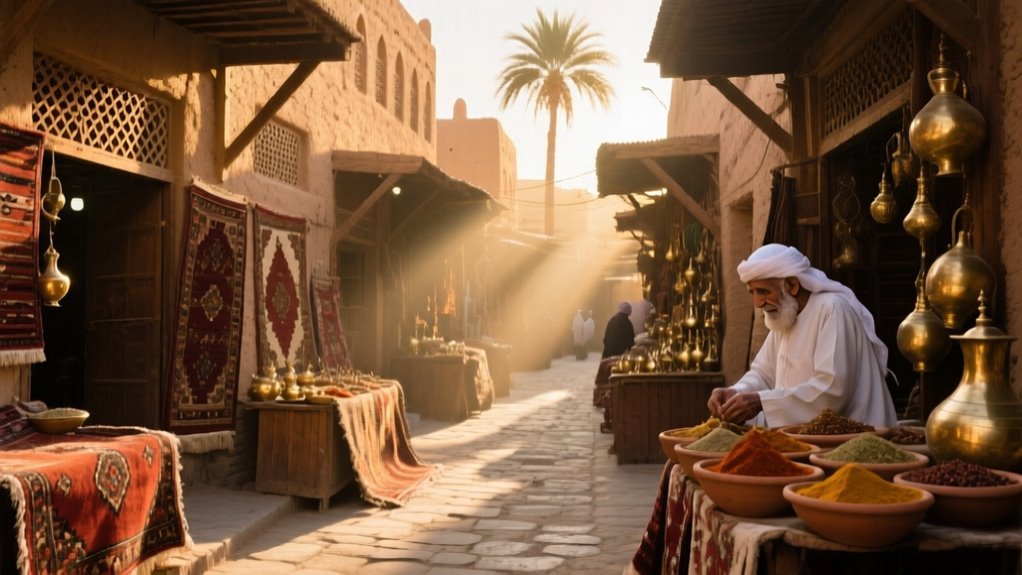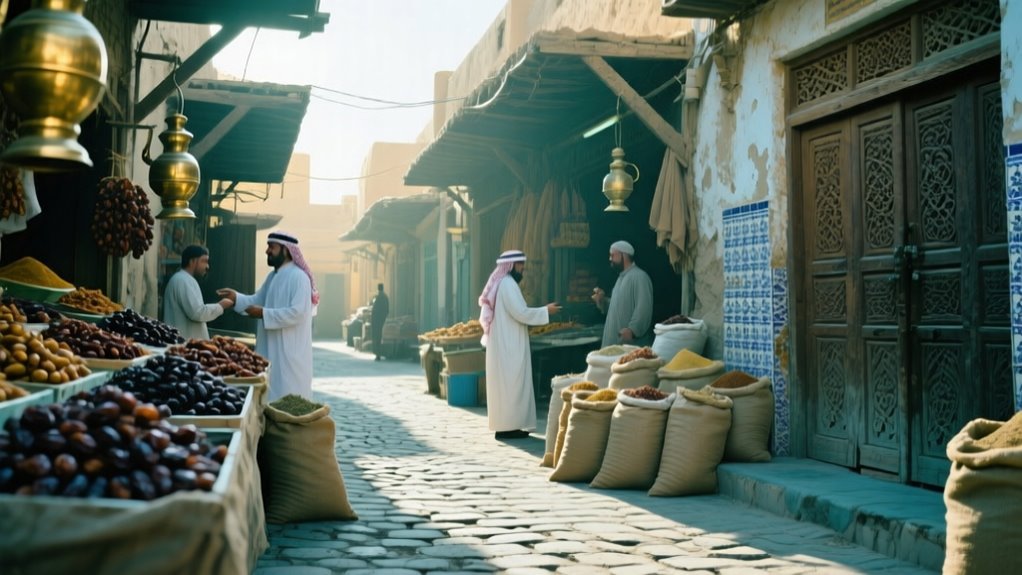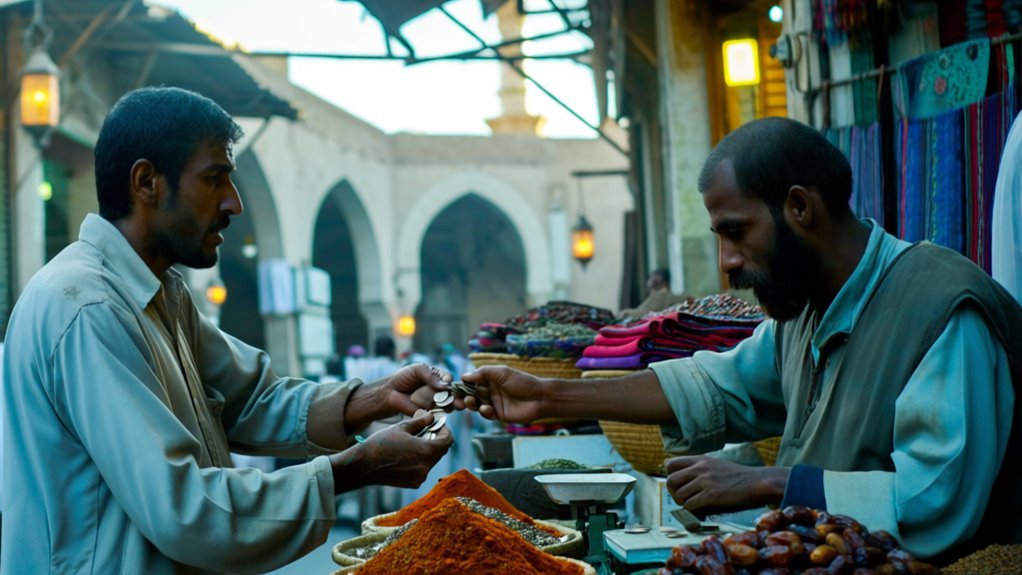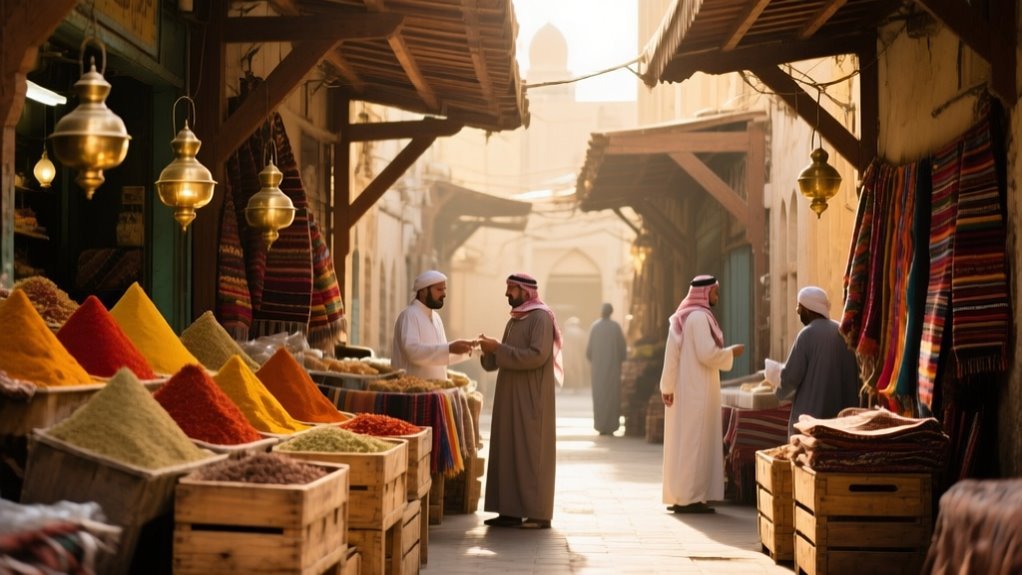If you explore Madinah’s traditional markets, you’ll discover vibrant hubs where centuries-old Islamic heritage meets lively commerce. Markets like Suwaiqah and Hakaya Heritage blend authentic crafts, from silver jewelry to textile arts, with rich culinary traditions such as Madinah-style sambousek and premium dates.
These spaces foster social bonds, preserve artisanal skills, and support local economies enhanced by modern infrastructure. You’re invited to experience how these markets keep culture alive while embracing innovation.
Key Takeaways
- Madinah’s traditional markets, like Al-Qomashah and Suwaiqah, date back over 430 years, primarily centered on textiles, gold, and perfumes.
- These markets preserve Islamic heritage, showcasing artisanal crafts, traditional foods, and fostering social and spiritual community bonds.
- Hakaya Heritage Market offers live demonstrations of pottery, weaving, calligraphy, leatherwork, and traditional Madinah cuisine.
- Traditional markets feature extended covered bazaars, creating vibrant cultural hubs with architecture reflecting Madinah’s historical and Bedouin roots.
- Festivals like Ramadan transform markets into lively venues of music, storytelling, decorations, and communal celebrations preserving cultural traditions.
Historical Roots of Madinah’s Marketplaces

Although Madinah’s traditional marketplaces trace their roots back to ancient times, their evolution was deeply shaped by the city’s strategic location and diverse communities.
Madinah’s marketplaces evolved over time, shaped profoundly by its strategic location and vibrant, diverse communities.
You’ll find these markets emerged alongside the early Muslim community, where a central marketplace was crucial for both economic and social life.
As migrants arrived, often with little more than hope, these trading hubs became essential for their economic integration.
The fertile oasis supported staple products like dates, anchoring commerce. Al-Baraka Market, for instance, specializes in premium Ajwa dates and date-based products, highlighting the ongoing importance of dates in the local economy.
Jewish communities added a layer of commercial strength and diversity.
Madinah’s position along caravan routes connecting Yemen, the Levant, and beyond introduced a wide variety of goods and cultural influences.
You’ll see agriculture supplied fresh produce easily, while Islamic ethics ensured fair trade, making these markets resilient and dynamic centers of exchange rooted in both tradition and strategic geography.
Overview of the Chefs Market
You’ll find Chefs Market just steps from the Prophet’s Mosque, making it a convenient stop for both pilgrims and locals craving authentic flavors. The market showcases traditional Madinah dishes like camel BBQ and mandi, deeply rooted in the region’s culinary heritage. Its location and food offerings together create a vibrant connection between cultural tradition and daily life. The market also reflects the cultural immersion typical of the region’s bustling bazaars. The lively and inviting atmosphere makes it ideal for families and friends to enjoy a meal together.
Traditional Food Offerings
When you explore Madinah’s Chefs Market, you experience a vibrant culinary hub where over 60 restaurants serve authentic dishes rooted in Arabian and wider Islamic traditions.
You’ll find signature plates like mandi, with its spiced rice and tender meat, and the unique goat head mandi, showcasing Madinah’s bold flavors. The market excels in presenting a fusion of traditional recipes, from Kabuli rice to manto dumplings, reflecting the region’s rich folklife.
As you navigate stalls, aromas and lively vendor chats immerse you in the city’s culinary heritage. This food market isn’t just about eating—it’s a social and cultural nucleus preserving centuries-old recipes while embracing dishes from across the Islamic world. The market is known for its seafood specialties, featuring fresh catches like prawns and red sea fish, prepared with authentic traditional techniques. Seafood specialities
It makes it essential for locals and visitors seeking an authentic taste of Madinah’s identity.
Proximity to Mosque
Madinah’s Chefs Market draws food lovers from across the city and beyond, but its location sets it apart from markets directly adjacent to the Prophet’s Mosque. Situated about 8.4 km away in the Al Jumuah district, it’s not a convenient stop immediately after prayer, unlike Al-Tabakha Market closer to the mosque. The market is notable for offering a diverse culinary selection, ranging from Middle Eastern to international cuisines, all prepared with high-quality ingredients.
You’ll need a short drive or private transport to visit since no direct shuttle services connect it with the mosque area.
While it doesn’t serve as a post-prayer dining hub, Chefs Market thrives as a culinary destination on its own, attracting locals, pilgrims, and tourists.
Its commercial setting and extensive amenities focus more on providing a vibrant, family-friendly food experience rather than catering to mosque-goers seeking immediate proximity.
Exploring Suwaiqah Market’s Heritage

Although centuries have passed since its founding, Suwaiqah Market remains an essential thread woven into the cultural fabric of Madinah. You’ll find that its origins over 430 years ago, just west of the Prophet’s Mosque, anchored its significance. Its location west of Prophet’s Mosque made it a central gathering place for many visitors.
Historically called Al-Qomashah due to its thriving textile trade, the market bustled with fabrics, gold, and perfumes, reflecting both daily life and religious celebrations. The market’s role in trade parallels the cultural integration seen in places with deep historical roots, such as those in Nepal’s heritage, where traditions and commerce blend.
Walking along Al-Ainiyah Street, you’d witness a vibrant hub serving locals and pilgrims alike.
The 1976 fire abruptly halted this rich commercial continuity, leaving a void in Madinah’s urban heritage.
Today, revival efforts under the “Al-Ainiyah and Suwaiqah” project fuse tradition with modern entrepreneurship. This allows you to experience a space where historical authenticity meets renewed cultural and economic vitality.
The Central Market’s Role in Commerce
Because it serves as a crucial hub on King Abdullah Road, the Central Market plays an essential role in sustaining Madinah’s commerce by connecting producers, retailers, and consumers efficiently within its vast 160,000-square-meter space.
You’ll find a diverse range of products—from fresh fruits and vegetables to meat, poultry, fish, dates, and household goods—facilitating both wholesale and retail trade.
The market’s infrastructure, including cold storage and loading facilities, supports smooth logistics. It also includes specialized shops for fish and dates, enhancing product variety.
The mosque and civil defense building address community needs. Additionally, the incorporation of modern facilities ensures the market meets evolving urban demands.
By incorporating innovations like electronic documentation and seasonal dates markets, it streamlines transactions and attracts varied entrepreneurs.
This marketplace isn’t just commercial; it’s a central artery, ensuring Madinah’s food and goods distribution stays dynamic and accessible to everyone involved.
Economic Contributions of Traditional Markets

When you explore the economic landscape of Madinah, traditional markets stand out as dynamic engines fueling growth across multiple sectors. These markets drive agricultural growth, especially during the rhutab harvest, boosting date-related manufacturing and packaging industries by 14% annually. Furthermore, these markets often serve as cultural hubs, reflecting the rich heritage similar to how the Grand Bazaar showcases Istanbul’s history and commerce.
Their influence extends into hospitality and retail, with projects like Rua Al Madinah capitalizing on increased tourism. During Ramadan, visitor spending surged by 64%. The hotel sector alone experienced a remarkable 42% annual increase in 2024, underscoring tourism’s expanding impact.
This commercial vitality is supported by Madinah’s robust infrastructure such as airports, ports, and the high-speed railway. Trade and logistics sectors expanded 54% in 2024, aided by these developments. Improved transportation infrastructure facilitates smoother flow of goods and people, much like the integrated transport connections linking Istanbul and Cappadocia’s key tourist sites.
Traditional markets also promote employment, with initiatives aiming to create tens of thousands of jobs. By integrating local production with expanding tourism, these markets underpin economic diversification.
They strengthen supply chains and contribute significantly to Madinah’s sustained growth beyond oil dependence.
Cultural Importance of Marketplaces in Madinah
How do traditional marketplaces in Madinah embody more than just commercial activity? They serve as vital cultural centers preserving Islamic heritage, fostering social bonds, and passing down artisanal crafts. When you visit markets like Hakaya Heritage or Chefs Market, you enter living museums where heritage thrives through architecture, crafts, and culinary traditions, especially the sacred symbolism of dates. These markets don’t just sell goods; they strengthen community ties and spiritual connections. Visitors to such markets often experience the vibrant atmosphere that echoes the rich history found in ancient cities like Cairo and Amman.
Traditional markets in Madinah often feature an extended, covered bazaar style characterized by long passages with shops on both sides, reflecting architectural customs of the region.
| Aspect | Cultural Role |
|---|---|
| Historical Roots | Markets near the Prophet’s Mosque |
| Artistic Preservation | Live crafts and storytelling |
| Culinary Heritage | Date markets with religious significance |
| Social Interaction | Daily social hubs and festive gatherings |
| Intergenerational Transfer | Skill-sharing to younger generations |
Through these marketplaces, Madinah’s heritage comes alive for locals and pilgrims alike.
Modernization and Development Initiatives
Although traditional markets in Madinah hold deep cultural significance, they’re also evolving through ambitious modernization projects that blend heritage with innovation. You’ll witness this transformation in the newly launched Central Dates Market within Food City, which streamlines agricultural trade across 1 million sq. meters. The market covers over 37,000 square meters in its initial phase, providing a modern platform for farmers and producers Central Dates Market. These initiatives don’t just upgrade infrastructure; they align with Saudi Vision 2030’s economic diversification, boosting entrepreneurship, especially among youth and women.
Renovations of historic markets like Souq Suwaiqah introduce modern craft facilities while preserving cultural identity. This balance between tradition and progress mirrors the experiences found in vibrant cultural destinations such as Bangkok, where innovation and heritage coexist.
You benefit from advanced market transparency and expanded economic opportunities, propelled by technology and strategic public-private partnerships.
The seasonal dates market offers 54 free vendor stalls, encouraging youth entrepreneurship.
Workshops graduate thousands, empowering women in crafts tied to market heritage.
Digital transaction systems protect stakeholders, ensuring fair trade across Madinah’s markets.
Infrastructure Supporting Market Activities
Since traditional markets are vital to Madinah’s economy, their supporting infrastructure is carefully designed to optimize every aspect of market activities.
Traditional markets in Madinah thrive due to thoughtfully optimized infrastructure supporting every facet of their activity.
The central market spans around 160,000 square meters and houses over 1,100 shops with specialized cold storage and yards for fresh produce. The market also benefits from connections to regional transport hubs, facilitating efficient supply routes.
Dedicated parking and loading bays streamline logistics, especially for refrigeration trucks, ensuring efficient supply chains.
The market layout allows smooth circulation and product display, enhancing competitive pricing through high-volume handling.
Transportation is crucial, with hundreds of trucks delivering local and imported goods connected to regional hubs like Prince Mohammad Bin Abdulaziz International Airport. Additionally, the integration of smart city technology fosters improved logistics management and tech-sector partnerships.
Utilities and public services maintain hygiene and safety, while municipal oversight ensures operational reliability.
This integrated infrastructure supports a steady supply, price stability, and readiness for demand surges, preserving the market’s essential role in Madinah.
Markets as Hubs of Community and Tradition
When you walk through Madinah’s traditional markets, you step into living museums that carefully preserve cultural heritage through their architecture and crafts. Hakaya Heritage Market, located near King Fahad Central Park, is a prime example, offering visitors an immersive journey into Saudi arts, crafts, and cuisine in its traditional marketplace.
You’ll see locals gathering during festivals, where social bonds strengthen over time-honored traditions and shared celebrations. These markets serve as essential spaces for fostering cultural encounters among community members.
Meanwhile, artisans and cooks keep age-old skills alive, offering handmade goods and authentic flavors that connect you directly to the city’s rich history.
Cultural Heritage Preservation
Because traditional markets in Madinah serve as living museums, they offer you a unique window into the city’s rich cultural heritage through authentic artisan crafts and practices. You witness artisans demonstrating pottery, weaving, and calligraphy firsthand, preserving skills passed down through generations.
The markets, like Hakaya Heritage Market, recreate old Madinah’s architectural style, immersing you in history while connecting past and present cultural identity. These vibrant hubs preserve ritualistic customs embedded in product presentation and artisanal techniques, ensuring cultural continuity amid modern commerce.
- Intricate textiles and oud sold alongside antiques sustain traditional craftsmanship.
- Markets safeguard premium date varieties and their culinary narratives.
- Local governance maintains quality standards, supporting artisans’ livelihoods and heritage preservation. Al-Tabah Market is a prime example, showcasing the vibrant atmosphere and traditional dishes that reflect Madinah’s culinary heritage.
Here, every transaction sustains Madinah’s cultural legacy.
Social Gatherings and Festivities
Traditional markets in Madinah don’t just safeguard heritage through crafts and architecture. They actively bring communities together, especially during festive seasons like Ramadan and Eid.
When you visit Suwaiqah or Souq Al Manakha, you’ll notice how these markets bustle with people exchanging greetings, stories, and prayers. This is especially true given their proximity to the Prophet’s Mosque.
The festive atmosphere becomes tangible with vibrant lights, traditional music, and cultural shows that engage everyone present. Ramzan Night Markets transform the city into a vibrant, enchanting hub with decorations and lights.
These festivities foster a shared sense of joy and identity.
You also witness multi-generational interactions, where family businesses thrive alongside local artisans. They reinforce community bonds and celebrate local heritage.
These celebrations offer you more than commerce. They immerse you in a lively social hub where Madinah’s local spirit shines.
The blend of Arabian heritage with Islamic traditions is felt through every sensory detail.
Traditional Crafts and Cuisine
Markets like Hakaya Heritage and Suwaiqah offer a vibrant window into Madinah’s artisanal and culinary heritage, where crafts and cuisine weave together to sustain cultural identity.
As you explore these markets, you witness artisans demonstrating camel leatherwork and silver jewelry making, preserving centuries-old skills. You’ll also find chefs offering traditional dishes like Madinah-style sambousek and an array of dates, essential to local culture.
These markets aren’t just places to buy—they are dynamic spaces where tradition lives. Their strategic location on historical trade routes underscores their importance as centers of commerce and community gathering.
Watch artisans merge production and sales in workshops that echo Islamic design motifs.
Taste regional delicacies at Hakaya Heritage’s culinary stalls, connecting food with storytelling.
Experience Suwaiqah’s rich textile and tailoring crafts rooted in Bedouin heritage.
Through crafts and cuisine, these markets embody Madinah’s heritage and community spirit.
Attracting Tourists Through Authentic Experiences
When you explore the vibrant bazaars near the Prophet’s Mosque, such as The Old Bazaar and Souq Al-Habbaba, you step into authentic local experiences shaped by handmade crafts, traditional perfumes, and regional dishes that tell Madinah’s rich cultural story. These markets offer immersive experiences combining cultural preservation with tourism, especially during Ramadan and Hajj festivals. You can savor traditional foods at Chefs Market or witness artisans crafting pottery and calligraphy in Hakaya Heritage Market, deepening your connection with Saudi heritage. Many travelers also seek enriching experiences through international tour packages that highlight historic and cultural landmarks, similar to those found in Beijing and Shanghai.
Frequently Asked Questions
What Are the Peak Visiting Hours for Madinah’s Traditional Markets?
You’ll find peak visiting hours for Madinah’s traditional markets mainly in the late afternoon and evening when the atmosphere livens up.
Weekends and special occasions like Ramadan or Saudi National Day see higher crowds. Arriving early during festivals helps you avoid the rush.
Seasonal factors, like the date harvest from August to October, also boost visits.
Evening cultural events further attract more visitors, making that time ideal for a vibrant market experience.
Are There Specific Days When Markets Offer Special Discounts or Events?
You won’t find a neatly scheduled “Discount Day” slapped on the calendar, ironically enough.
While markets don’t officially offer special discount days or widely advertised events, you’ll find bargaining is the real art here — prices flex depending on your skill.
Seasonal products and major Islamic celebrations may subtly influence offers, but the excitement comes from exploring, engaging with vendors, and discovering hidden gems, rather than waiting for a sale announcement.
Is Bargaining Customary in Madinah’s Traditional Markets?
Yes, bargaining is customary in Madinah’s traditional markets, but it varies depending on the vendor and goods. You’ll find prices somewhat negotiable, especially in antique or local craft stalls.
Approach vendors respectfully and politely to build rapport, which often leads to better deals. Keep in mind, the bargaining style is more subtle compared to other regions, so being culturally sensitive and flexible in your offers will help you secure fair prices.
What Are the Accepted Payment Methods in These Marketplaces?
You’ll find that cash in Saudi Riyals remains the most widely accepted payment method, especially for small vendors and bargaining scenarios.
While some established stalls might accept Visa, Mastercard, or even Sharia-compliant credit cards, card terminals aren’t universal.
Debit cards dominate online payments but are less common in person.
It’s smart to carry cash for flexibility but also consider prepaid travel cards or mobile wallets for added convenience and security during your visits.
Are the Markets Wheelchair Accessible and Family-Friendly?
Traversing these markets is like threading a needle—wheelchair accessibility is limited, with uneven paths and narrow streets blocking smooth passage.
You won’t find many ramps or family amenities, making it tough for both wheelchair users and families with children.
Crowds add to the challenge, so you’ll need extra care.
While nearby areas offer better support, inside the markets, expect to rely on informal help rather than structured accessibility or family-friendly facilities.
Conclusion
When you wander through Madinah’s traditional markets, you’re stepping into living history, where every stall tells a story.
These vibrant hubs don’t just fuel the economy; they nurture community bonds and preserve cultural heritage.
As modernization weaves into their fabric, the markets balance tradition with progress, inviting you to experience authenticity firsthand.
So, won’t you let Madinah’s marketplaces charm you, bridging past and present in a dance as old as time itself?


0 Comment